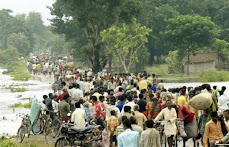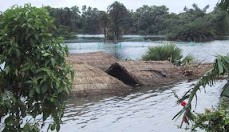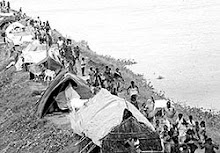The technocentric assumption that acts as a rationale for embankments is guided by an application of �normal science� of hydraulic engineering, through various channel improvement methods (such as river straightening, dredging and snugging) the swing of the floodwater can be controlled.
The Kosi river has shifted westwards by 160 km over the past 250 years. It is this meandering nature of the river systems that has the maximum available energy producing currents and should be more of concern for river basin management, especially for flood control.
This natural tendency to meander and sinuosity of this river system disproves the traditional �steady-state� equilibrium approach of the engineers and calls for a comprehensive assessment of the river system.
Embankments have arrested the natural fertilisation of the flood plain and deprived the people who depend on these fertile
soils for livelihood. Further, embankments provided a false sense of security to the increasing population to settle down along the embankments.
The Ganga Flood Control Board was set up in 1972 by a resolution of Government of India. The Ganga Flood Control Commission (GFCC) was set up as per Clause 5 of the resolution to undertake specific works in the Ganga Basin and for assisting the Ganga Flood Control Boards.
The GFCC is expected to prepare master plan of the basin to deal with problems emerging from flood erosion and waterlogging in the region. The implementation of these will be carried out by the appropriate riparian state. A chairman appointed by the Government of India (GOI) heads the Commission. GOI also appoints two full time members. Basin states appoint part time members of the commission.
It is clear from the origin, functions and constitution of these institutions that they are all structured for planning, design and implementation of large projects. It is also clear that they do not even intend to be participation oriented or open bodies.
These institutions have failed to encompass the needs, resources and priorities of whole river basin. The failures are largely guided by technocentric approach that have misunderstood the river systems
and communities as being stable and that they are liable to be controlled for development.
Large-scale storage structures impound and divert river water are justified on the basis that floods are caused due to upstream catchment. Therefore, controlling this catchment water through large dams will reduce flooding in the downstream, the stored water can be utilised to generate power and for irrigation in the flood plains. First and foremost is the assumption that floods are caused from upstream catchment. The technocrats fail to recognise the existence of larger catchment in the lower part of the basin, which is also capable of flooding.
The Bihar State has built about 3465 kms of embankments along its rivers till 1998 (only 160 km in 1952) and a sum of Rs 7.46 billion have been spent till 1998. However, these embankments have only had negative impact.
The embankment tries to arrest the natural dispersion of sediment on the floodplains, thereby increasing deposition, raising the level of riverbed and later breaking of embankments, causing floods and waterlogging.
The flood prone area in Bihar has increased from 25 lakh hectares in 1952 to 68.9 hectares in 1998.
Who will diagnose the problem of this huge increase in the flood prone area?
How to arrest the increase in flood prone area?
Human displacement and migration in Bihar is worse than any other known displacements in India/South Asia. Who is responsible for it?
Who should be held accountable for failure and who should be made liable for past failures?
Historically, floods and their control have never been a big issue in the Ganga-Brahmaputra basin, as it is today. Floods became a major issue after the British occupied India. When they examined the Ganga basin, they believed that if it could be made “flood-free”, they could levy a tax in return for such protection.
Monday, 17 March 2008
Subscribe to:
Post Comments (Atom)








1 comment:
A new book "The Raj Lives: India In Nepal" by Nepali journalist
Sanjay Upadhya has erred in noting that "The Kosi project
primarily benefited India, which received 97 per cent of the water.
India irrigated millions of hectares of land, resulting in tens of
billions of dollars' worth of annual production. Nepal ended up with
vast tracts of land under water."
The fact is that it primarily harmed India. Even a tour of the Kosi region
within Bihar can illustrate the harm. Had the Kosi project been indeed
beneficial, Biharis would not have chosen to migrate to other states in search
of the most menial of jobs?.
It is true that the injustice done is not on anyone�s agenda today but this
holds true for both Bihar as well Nepal.
If the author had the benefit of going through the findings of the
Fact Finding Team on Bihar flood that also visited Saptari, on Nepal side, one
is sure he would have assessed the benefits differently. The fact is that the
Ministers of India and Nepal did not take voice of their respective into
cognisance as result there is misery on both sides. The team also met the former
Irrigation Minister of Nepal (a contemporary of Lalit Narayan Mishra)who
corroborated that the project was a result of a financial assistance for
development of his region that was granted by his Indian counterparts.
Had Kosi project been beneficial to Bihar, likes of Parameshwar Kunwar, village
Tarahi would not have been arrested for participating in a black flag
demonstration against Dr Rajendra Prasad, the President of India in 1955 when he
had come to lay the foundation stone for the eastern Kosi embankment?. The
protest of some 15 to 20 thousand people did not yield any result. Many went to
jail several times. But to no avail.
The protesters knew that embankments would ruin their lives and it has done so.
Dr Dinesh Kumar Mishra, a member of the Fact Finding Team notes in an earlier
article "Refugees of the Kosi" published in Himal South Asian that four decades
ago, going against scientific wisdom, the dam builders of India decided to
construct embankments on the Kosi river in north Bihar. That has resulted in an
untold story of the misery of this decision made by faceless technocrats and
unthinking politicians.
He writes, "People like Parameshwar Kunwar had submitted a 20-page memorandum
against the Kosi Project in 1957 to Dr Shri Krishna Sinha, the chief minister of
Bihar. The rejoinder came from T.P. Singh, Administrator of the Kosi Project in
English."
This ilk of bureaucrats and politicians still perpetuate the misery of the
people .
Post a Comment